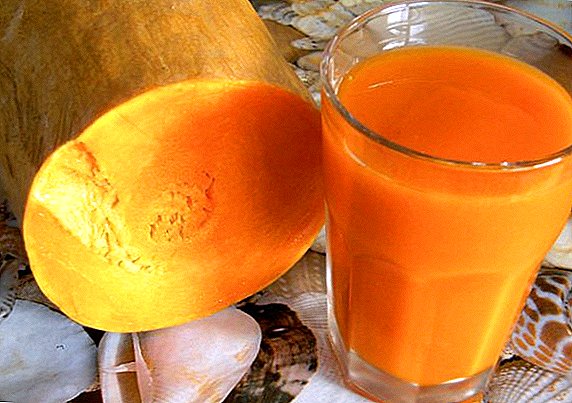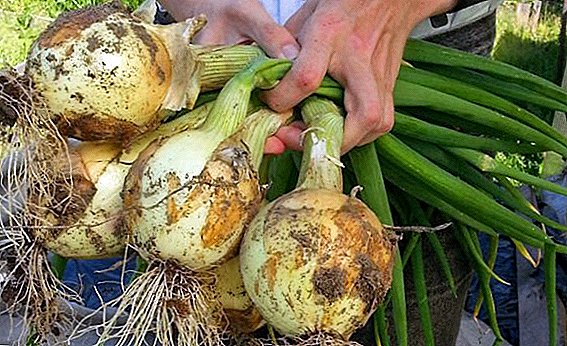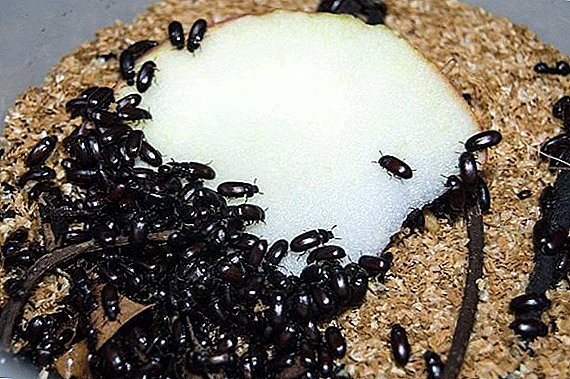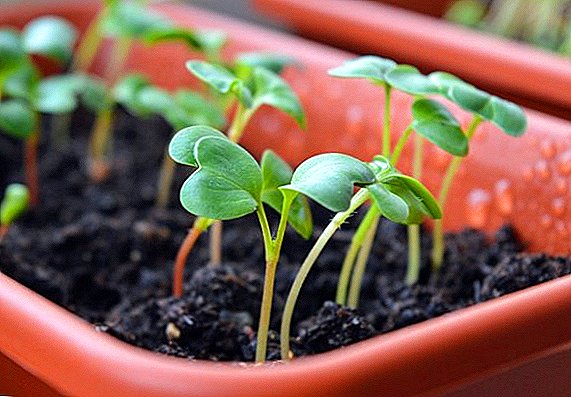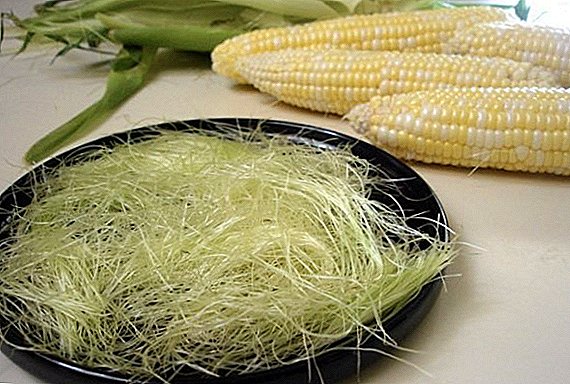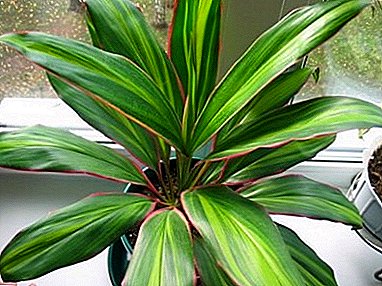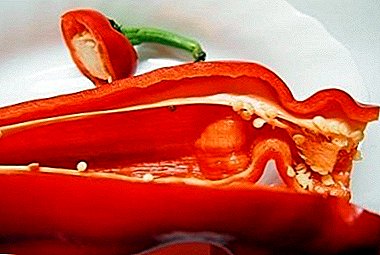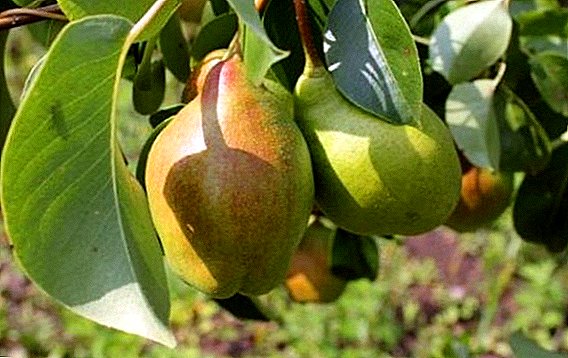 To date, many varieties of pears of winter maturity with different taste qualities have been developed. One of them is the variety "Kyrgyz Winter", which can grow in cold climates. However, to obtain a rich harvest, you must follow a number of rules for planting and seasonal tree care.
To date, many varieties of pears of winter maturity with different taste qualities have been developed. One of them is the variety "Kyrgyz Winter", which can grow in cold climates. However, to obtain a rich harvest, you must follow a number of rules for planting and seasonal tree care.
Inference history
The pear variety "Kyrgyz Winter" is developed for regions where the weather conditions for growing fruit trees are severe. It was obtained by Kyrgyz breeders by crossing two varieties: "Forest Beauty" and "Winter Bere".
Did you know? About pear was known for 1000 years BC. In Europe, the pear began to spread widely in the XIX century, and it was brought to Kiev from Byzantium.
Description and distinctive features of the variety
When describing pear varieties "Kyrgyz Winter" we can say that its main advantage is the ability to grow in areas with adverse weather conditions and at the same time give high yields.
Wood
 Tree varieties "Kyrgyz Winter" is characterized by the following features:
Tree varieties "Kyrgyz Winter" is characterized by the following features:
- medium-sized with a pyramidal, not thickened crown shape; in autumn it sheds foliage;
- It is grafted on the middle rootstock quince and has a branched root system going deep into the ground;
- the leaves are oval in shape, slightly elongated and pointed at the end, outside the color is green with a glossy sheen, on the inside it is gray-green;
- depending on the climatic conditions of planting, flowering occurs in April or May. The flowers are white, very fragrant, up to 3 centimeters in diameter, which are assembled in brushes from 3 to 9 pieces;
- before the first fruits appear, the branches must be folded over by 60 ° and fixed until they themselves assume the correct position;
- the variety is self-fertile, but for better pollination you need to plant several trees nearby;
- does not freeze when frost is strong enough;
- fruits under good conditions up to 30 years, the fruits are laid on kolchatkah;
- trees are not affected by scab, thermal burns and bacterial cancer;
- grows best in temperate latitudes.
Fruits
 Characteristic:
Characteristic:
- large fruit, weighing up to 250 grams;
- shape oblong-rounded;
- the skin is light green, at the time of full maturity, the color changes to rich yellow with a red blush all over the fruit;
- the pulp is juicy creamy-yellow, dense, granular with a tart and pleasant taste;
- pears ripen in October;
- fruits tolerate transportation and can be stored in the refrigerator until mid-spring.
Important! To obtain high-quality fruits, winter pear varieties must ripen for 90 days at a temperature not higher than 10 ° C.
How to choose the seedlings
Varietal seedlings are best purchased in nurseries or specialty stores. In this case, you need to pay attention:
- appearance - clean with no signs of lethargy. Be sure to attach a label indicating the type and description of the growing area;
- root system - The tree must have up to 5 main and 3 additional roots with a length of at least 0.3 meters. They look bright, without rot and various growths.
Choosing the right place
Since these pears belong to the early ripening variety, it is good to use them to create the so-called "intensive home garden".  The requirements for the place where it will be broken are:
The requirements for the place where it will be broken are:
- the site is well illuminated by the sun - although the pear can grow in partial shade, but it will not bear fruit there;
- plant better on hills and slopes, with deep groundwater, as the roots of the tree can reach a depth of 8 meters;
- thick fertile layer of soil, with thick loam beneath. Pear grows poorly on heavy and sandy soils;
- the site must be protected from the prevailing winds;
- If possible, choose a site for landing on the site from the west or south-west side.
Site preparation
Before planting the pears, it is necessary to carry out preparatory work, which will then help the seedlings to quickly take root in a new place.  They consist of several stages:
They consist of several stages:
- for the autumn planting pit is prepared for the month, and for the spring - since the fall. Its size depends on the age of the seedling - the annuals need a depth of up to 0.5 meters, two-year-olds up to 0.7 meters. The diameter of the pit should be comfortable for the location of the roots;
- A wooden stake is driven into the center, protruding above the ground by at least 0.5 meters. He will be the support of the future sapling;
- Fertilizers are piled to the bottom - ammonium nitrate and superphosphate up to two kilograms in total (if fertilizers are in granules, you need to take one kilogram). We remember organic matter - no more than 10 kilograms. If the pit is prepared on sandy soil, you must make a half-bucket of peat;
- 60% of the top is fertile soil, so that the roots are not in contact with fertilizers.

Important! Fertilizers should not be applied more than normal, as an overdose can cause root burns and the seedling will die.
Step-by-step instructions for planting seedlings
It is better to perform this procedure together - one keeps the sapling vertically, and the other does all the operations. The process of planting pears is as follows:
- At a sapling the basic roots are cut with a sharp pruner and immersed for a few minutes in a liquid clay solution for good impregnation;
- In the center of the pit, a small mound is formed, on which the prepared seedling is installed, necessarily from the north of the clogged support;
- The roots are evenly distributed in the pit without bends and fractures, directed downwards;
- Carefully poured into layers of prepared soil, slightly tamping it. At the same time with each adding the seedling is shaken, maintaining a vertical position. This allows you to remove the resulting air voids. The vaccination site should be 4 centimeters above the ground;
- Plentifully fill the pit with water so that it completely soaks the soil. When this tree settles down below, and the root of the neck falls to the level of the soil. This is the principle of proper planting;
- Pruning is carried out at a height of up to 0.8 meters to form a crown on a kidney that has matured well. If there are shoots at a height of up to 50 centimeters, they are completely removed;
- The tree is tied to a support, and the tree trunk must be mulched to preserve moisture.
Important! If the roots are cut incorrectly before planting, the tree will hurt for a long time and take root in a new place. In one-year seedlings, the main roots are cut to a thickness of 2 millimeters, biennial to a thickness of 4 millimeters. This technique allows the roots to quickly absorb water and nutrients.
Seasonal care features
Anyone who grows Kyrgyz Winter Winter pear trees on a plot probably wants to produce a rich harvest. Seasonal work for this should be:
- in the care of the soil;
- in timely fertilizing with fertilizers;
- in preventive operations;
- in the design of the crown of trees;
- preparing them for the winter.
Soil care
Since this pear is a winter variety, a large amount of water is not needed, but drought does not benefit. Watering young trees is necessary every 8-10 days, pouring up to 15 liters of water under the root. For adult plants, this procedure is carried out once every two weeks with the addition of up to 30 liters of water in the stem. When the fruits begin to ripen, watering stops before harvest.
Watering young trees is necessary every 8-10 days, pouring up to 15 liters of water under the root. For adult plants, this procedure is carried out once every two weeks with the addition of up to 30 liters of water in the stem. When the fruits begin to ripen, watering stops before harvest.
These works are carried out in the evening, and the next day, so that the soil around the trees does not crack, it must be loosened. Such procedures not only open the access of oxygen to the root system, but also allow you to remove weeds that appear in tree trunks.
Familiarize yourself with the cultivation of pear cultivars: Otradnenskaya, Lada, Fairy Tale, Veles, Rogneda, Nika, Talgar Beauty, Dyushes, Petrovskaya, Severyanka, Avgustovskaya dew, Kokin, Bryansk Beauty, Thumbelina, Hera, Klapp's Favorite, Marble, Tenderness.
To prevent moisture from evaporating quickly from the ground, soil mulching is used to detain it. As mulch, you can use any material, such as peat or sawdust, laying it in a layer of up to 10 centimeters.
Top dressing
For good growth and fruiting tree necessarily need fertilizer.  If the leaf began to turn yellow, the fruit began to fall, and the pear stopped growing - it simply lacks nitrogen. The fruit bud is poorly formed, and then, respectively, there are no pears - the tree is deficient in phosphorus. Poor annual shoot growth - potassium is responsible for this.
If the leaf began to turn yellow, the fruit began to fall, and the pear stopped growing - it simply lacks nitrogen. The fruit bud is poorly formed, and then, respectively, there are no pears - the tree is deficient in phosphorus. Poor annual shoot growth - potassium is responsible for this.
Important! Young trees are fed only with nitrogen fertilizers, and just planted seedlings for two years do not need any additional feeding.Fertilizers need to:
- In early spring, a bare urea must be treated with urea solution. If for some reason this has not been done, it is necessary to apply nitrogen fertilizers to the soil. You can use a solution of urea (per 10 liters of water, 600 grams of substance), saltpeter (30 grams per 1 square meter) or a solution of chicken manure (1:20);
- after flowering in May organic matter is introduced into the soil to a depth of 10 centimeters. You can replace the solution of nitroammofoski in a ratio of 1: 200 - 30 liters under the tree. Such feeding will speed up the growing season and improve the quality of future fruits.
- at the end of June, foliar treatment with nitrogen-containing fertilizers is necessary;
- in July, another such treatment, and after 15 days for fruiting trees, phosphorus-potassium additives are buried in the ground around the trunk;
- until the second half of September, you can spray a solution of urea (as in the spring on a bare tree). In the fall, only liquid mineral fertilizers are applied to the soil. An example of a solution is a tablespoon of potassium chloride and two spoons of superphosphate per bucket of water. Young plants are fed wood ash for digging at the rate of 130 grams per square meter.
Preventive spraying
 In early spring, spraying from diseases and awakening insects is combined with the first feeding, which is carried out on a bare tree. If the kidneys are swollen, carbamide can burn them, and they will die - it is better to use ready-made biologics such as Fitoverma, Akarina and others. To increase the resistance of the tree to adverse factors, a good result is obtained by spraying with liquid "Zircon" or "Ecoberin".
In early spring, spraying from diseases and awakening insects is combined with the first feeding, which is carried out on a bare tree. If the kidneys are swollen, carbamide can burn them, and they will die - it is better to use ready-made biologics such as Fitoverma, Akarina and others. To increase the resistance of the tree to adverse factors, a good result is obtained by spraying with liquid "Zircon" or "Ecoberin".
In the fall, trees need to be protected from the larvae of beetles, which hide from the cold in cracks in the bark and shallow in the ground. Plants and the ground around the trunks are sprayed with a solution of "Nitrofen" or one-percent Bordeaux mixture. In spring and autumn, standard whitewashing of tree trunks with lime mortar is mandatory.
Cropping and crown formation
To harvest the crown in the shape of a pyramid is considered the most convenient. This form must be formed, starting from the second year of the plant life.  These procedures are carried out as follows:
These procedures are carried out as follows:
- after planting the seedlings determine the skeletal branches, the rest are removed. The main conductor is cut to one-fourth the length and cleaned well of processes below the first tier of the branches;
- in the second year in the spring, the trunk is cut by 20 centimeters, and the skeletal branches are cut by no more than 5 centimeters and stretch them with a string, so that the angle of inclination is 60 °. There should be two fruitful shoots on the main branches;
- every spring, sanitary pruning of the branches is carried out, removing the competing branches growing vertically inside the crown, intersecting and broken. Last year's growth is cut to 1/3 of the length;
- in the fall, they also cut dry, broken and sore branches. Large sections are immediately treated with garden pitch.
Important! When pruning pear trees need to use the ladder, because the branches of plants are very fragile and quickly break.
Protection against cold and rodents
Since this pear variety is frost-resistant, the trees do not need winter shelter, but the bark of the trees is food for rodents and hares. Therefore, in order to preserve it, it is necessary to tie the trunk to a height of up to 1 meter with a dense cordon or cloth, previously soaked with rodent deterrent.  Young saplings must necessarily impose fir branches and tightly wrap sacking, it will be a reliable protection not only from the beast, but also from frost. Earthen clod around the trunk must be peated or peeled with a layer of 15 centimeters. After the snow falls, you need to sketch it around the trunks to form a snowdrift.
Young saplings must necessarily impose fir branches and tightly wrap sacking, it will be a reliable protection not only from the beast, but also from frost. Earthen clod around the trunk must be peated or peeled with a layer of 15 centimeters. After the snow falls, you need to sketch it around the trunks to form a snowdrift.
Did you know? The healing properties of pears were known 5,000 years ago and now they are widely used in traditional medicine to lower the temperature, with stomach pain, as a diuretic.
Acquainted with such pears as "Kyrgyz Winter", you can safely plant this variety on your site. Trees will not cause much hassle in seasonal care. If you make fertilizer on time, water, carry out preventive treatment from pests, a large crop is ensured. Since pears are well preserved, you will have fresh fruit on the table until mid-spring.


